Attached files
| file | filename |
|---|---|
| 8-K - 8-K - FEDERAL HOME LOAN MORTGAGE CORP | d721353d8k.htm |
| EX-99.1 - EXHIBIT 99.1 - FEDERAL HOME LOAN MORTGAGE CORP | d721353dex991.htm |
 First
Quarter 2014 Financial Results
Supplement
May 8, 2014
Exhibit 99.2 |
 2
Table of contents
Business Results
Credit Supplement
3 -
Quarterly Financial Results
20 -
National Home Prices
4 -
Comprehensive Income
21 -
State-by-State Home Prices: June 2006 to March 2014
5 -
Senior Preferred Stock Purchase Agreement with Treasury
22 -
State-by-State Home Prices: March 2013 to March 2014
6 -
Treasury Draw Requests and Dividend Payments
23 -
Mortgage Market and Freddie Mac Serious Delinquency Rates
7 -
Total Equity and Senior Preferred Stock Activity
24 -
8 -
Single-Family Guarantee Fees Charged on New Acquisitions
25 -
9 -
Structured
Agency
Credit
Risk
(STACR
®
)
Debt
Note
Issuances
26 -
10 -
Loan Loss Reserves
27 -
11 -
28 -
12 -
29 -
13 -
30 -
14 -
31 -
15 -
32 -
Multifamily Portfolio Composition
16 -
33 -
Multifamily Securitization Volume
17 -
34 -
Multifamily New Business Volume by State
18 -
35 -
Multifamily Mortgage Portfolio UPB Concentration by State
36 -
Multifamily Mortgage Portfolio by Attribute
37 -
Multifamily Mortgage Portfolio by Attribute, Continued
38 -
Multifamily Market and Freddie Mac Delinquency Rates
Loan Purpose of Single-Family Credit Guarantee Portfolio
Purchases
Credit Quality of Single-Family Credit Guarantee Portfolio Purchases
Single-Family Credit Guarantee Portfolio Characteristics
Single-Family 1Q 2014 Credit Losses and REO by Region and State
Single-Family Credit Profile by Book Year and Product Feature
Single-Family Serious Delinquency Rates by State and Region
Aging of Single-Family Seriously Delinquent Loans by Judicial and
Non-Judicial States
Real Estate Owned
Single-Family Cumulative Foreclosure Transfer and Short Sale
Rates by Book Year
Market Liquidity Provided
Single-Family Refinance Activity
Performance of Single-Family Modified Loans
Single-Family Loan Modifications
Single-Family Loan Workouts
Administrative Expenses
Purchase Agreement Portfolio Limits |
 3
Quarterly financial results
Line 3:
A shift from derivative gains in 4Q13 to
derivative losses in 1Q14 primarily driven by
losses on the net pay-fixed swap portfolio as long-
term interest rates decreased.
Line 13:
Higher income tax expense primarily
driven by a higher effective tax rate in 1Q14. In
2014, the company expects its effective tax rate to
be marginally below the statutory rate of 35
percent.
Note: Columns and rows may not add due to rounding.
($ Billions)
1Q 2014
vs
4Q 2013
1Q 2014
4Q 2013
1
Net interest income
$3.8
$3.5
($0.3)
2
(Provision) benefit for credit losses
0.2
(0.1)
(0.3)
3
Derivative gains (losses)
1.0
(2.4)
(3.3)
4
Net impairment of available-for-sale
securities recognized in earnings
(1.3)
(0.4)
0.9
5
Other non-interest income
6.1
5.8
(0.3)
6
Non-interest income
5.8
3.1
(2.6)
7
Total administrative expenses
(0.5)
(0.5)
0.0
8
Real estate owned operations expense
(0.0)
(0.1)
(0.0)
9
Temporary Payroll Tax Cut Continuation
Act of 2011 expense
(0.2)
(0.2)
(0.0)
10
Other non-interest income (expense)
0.3
(0.1)
(0.4)
11
Non-interest expense
(0.4)
(0.8)
(0.4)
12
Pre-tax income
9.3
5.8
(3.6)
13
Income tax expense
(0.7)
(1.7)
(1.0)
14
Net income
8.6
4.0
(4.6)
15
Total other comprehensive income,
net of taxes
1.2
0.5
(0.7)
16
Comprehensive income
$9.8
$4.5
($5.3) |
 4
Comprehensive income
A
B
C = A + B
$ Billions
$1.8
$2.9
$5.6
$5.7
$7.0
$4.4
$30.4
$9.8
$4.5
1Q
2012
2Q
2012
3Q
2012
4Q
2012
1Q
2013
2Q
2013
3Q
2013
¹
4Q
2013
1Q
2014
Net income
Comprehensive income
1
2
Total
other
comprehensive
income
(loss),
net
of
taxes
²
Net income and Comprehensive income include $23.9 billion non-cash benefit from releasing the
valuation allowance on deferred tax assets.
Consists of the after-tax changes in: (a) the unrealized gains and losses on
available-for-sale securities; (b) the effective portion of derivatives previously designated as cash flow
hedges; and (c) defined benefit plans. |
 Senior
Preferred Stock Purchase Agreement with Treasury
Senior
preferred
stock
outstanding
and
held
by
Treasury
remained
$72.3
billion at
March 31, 2014.
1
»
Dividend payments do not reduce prior Treasury draws.
»
Any future draws will increase the balance of senior preferred stock
outstanding. Since entering conservatorship in September 2008, Freddie Mac
has: »
Received cumulative draws of $71.3 billion from Treasury. No draws have been
requested for the past eight quarters; last draw request was $19 million for
first quarter 2012.
Freddie Mac’s net worth was $6.9 billion at March 31, 2014.
»
Capital
reserve
amount
is
$2.4
billion
for
quarterly
payments
in
2014,
and
will
be
reduced
by
$600 million each year thereafter until it reaches zero on January 1, 2018.
»
Dividend obligation to Treasury will be $4.5 billion in June 2014.
»
Aggregate cash dividends paid to Treasury will total $86.3 billion including the
June dividend obligation, versus cumulative cash draws of $71.3 billion
received from Treasury through March 31, 2014.
The amount of remaining Treasury funding currently available to Freddie Mac under
the
Purchase
Agreement
is
$140.5
billion.
Any
future
draws
will
reduce
this
amount.
1
5
Senior preferred stock outstanding of $72.3 billion at March 31, 2014 includes cumulative draws of
$71.3 billion plus the initial liquidation preference of $1 billion. |
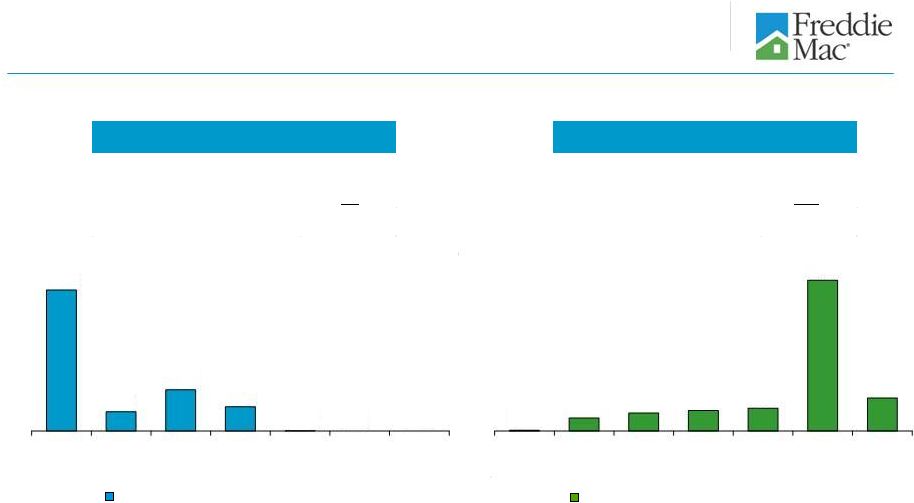 Dividend Payments to Treasury
Draw Requests from Treasury
6
Treasury draw requests and dividend payments
$ Billions
5
4
Draws From Treasury
Dividend Payments to Treasury
3
($ Billions)
Cumulative
Total
Total
Senior
Preferred
Stock
Outstanding
$72.3
Less:
Initial
Liquidation
Preference
1
$1.0
Treasury Draws
$71.3
($ Billions)
Cumulative
Total
Dividend Payments as of 03/31/14
$81.8
2Q 2014 Dividend Obligation
$4.5
Total
Dividend
Payments
2
$86.3
$44.6
$6.1
$13.0
$7.6
$0.02
$0.0
$0.0
2008
2009
2010
2011
2012
2013
YTD
2014
$0.2
$4.1
$5.7
$6.5
$7.2
$47.6
$10.4
2008
2009
2010
2011
2012
2013
YTD
2014
The initial $1 billion liquidation preference of senior preferred stock was issued to Treasury in
September 2008 as consideration for Treasury’s funding commitment. The company
received no cash proceeds as a result of issuing this initial $1 billion liquidation preference of
senior preferred stock. Amounts may not add due to rounding.
Amount does not include the June 2014 dividend obligation of $4.5 billion.
Annual amounts represent the total draws requested based on Freddie Mac’s quarterly net deficits
for the periods presented. Draw requests are funded in the subsequent quarter (e.g., $19
million draw request for 1Q 2012 was funded in 2Q 2012). Represents quarterly cash dividends paid by Freddie Mac to Treasury during the periods presented.
Through December 31, 2012, Treasury was entitled to receive cumulative quarterly cash dividends
at the annual rate of 10% per year on the liquidation preference of the senior preferred stock. However, the fixed dividend rate was replaced with a net
worth sweep dividend payment beginning in the first quarter of 2013. See the company’s
Annual Report on Form 10-K for the year ended December 31, 2013 for more information.
1
2
3
4
5 |
 7
Total equity and Senior Preferred Stock activity
1
See the company’s 10-Q for the quarter ended March 31, 2014 for a description of the
company’s dividend obligation to Treasury. 2
Includes the initial liquidation preference of Freddie Mac’s senior preferred stock of $1.0
billion. Note: Columns may not add due to rounding.
($ Billions)
1Q 2013
2Q 2013
3Q 2013
4Q 2013
1Q 2014
1
Beginning
balance
-
Total
equity
/
GAAP
net
worth
$8.8
$10.0
$7.4
$33.4
$12.8
2
Capital draw funded by Treasury
-
-
-
-
-
3
Net income
4.6
5.0
30.5
8.6
4.0
4
Total other comprehensive income (loss), net of taxes
2.4
(0.6)
(0.0)
1.2
0.5
5
Comprehensive income
7.0
4.4
30.4
9.8
4.5
6
Dividends paid to Treasury
(5.8)
(7.0)
(4.4)
(30.4)
(10.4)
7
Other
-
-
-
-
-
8
Ending
balance
-
Total
equity
/
GAAP
net
worth
¹
$10.0
$7.4
$33.4
$12.8
$6.9
9
Aggregate
liquidation
preference
of
the
senior
preferred
stock
²
$72.3
$72.3
$72.3
$72.3
$72.3
10
Remaining senior preferred stock funding available
$140.5
$140.5
$140.5
$140.5
$140.5 |
 8
Single-family guarantee fees charged on new
acquisitions
Quarterly
In Basis Points, Annualized
Annual
In Basis Points
Legislated
10
Basis
Point
Guarantee
Fee
Remitted
to
Treasury
¹
Single-Family
Guarantee
Fee
Charged
on
New
Acquisitions
(excluding
amounts
remitted
to
Treasury)
²
Effective April 1, 2012, guarantee fees charged on single-family loans sold to Freddie Mac were
increased by 10 basis points. Under the Temporary Payroll Tax Cut Continuation Act of
2011, Freddie Mac is required to remit the proceeds from this increase to Treasury. Given the April 1, 2012 effective date, the impact of the increase on average guarantee
fees for full-year 2012 was 7.5 basis points.
Represents the estimated rate of management and guarantee fees for new acquisitions during the period
assuming amortization of delivery fees using the estimated life of the related loans rather
than the original contractual maturity date of the related loans. Also includes the effect of pricing adjustments that are based on the relative performance of our
PCs compared to comparable Fannie Mae securities. 1
2 |
 $0.5
$0.6
$1.0
3Q13
4Q13
1Q14
Structured
Agency
Credit
Risk
(STACR
®
)
debt
note
issuances
9
$ Billions
1
The reference pool for the April 2014 STACR debt note issuance represented an
unpaid principal balance of $28.1 billion. 2
Includes the first loss risk held by Freddie Mac.
$22.6
$35.3
$32.4
STACR Reference Pool
²
($ Billions)
($ Billions)
Cumulative
Total
STACR Debt Note Issuance as of 03/31/14
$2.1
April 2014
Issuance¹
$1.0
Total Issuance
$3.1 |
 10
Loan loss reserves
1
1
Includes amounts related to certain loans purchased under financial guarantees and
reflected within other expenses on the company’s consolidated statements of comprehensive
income.
2
Consists of the allowance for loan losses and the reserve for guarantee losses.
2
$ Billions
($3.3)
($2.9)
($3.0)
($2.5)
($2.1)
($1.9)
($0.6)
($0.4)
($0.9)
$1.8
$0.2
$0.6
($0.7)
($0.5)
($0.6)
($1.1)
($0.2)
$0.1
$38.3
$35.8
$33.8
$30.9
$28.6
$26.4
$25.0
$24.7
$24.1
1Q 2012
2Q 2012
3Q 2012
4Q 2012
1Q 2013
2Q 2013
3Q 2013
4Q 2013
1Q 2014
Net Charge-offs
Provision (Benefit)
Loan Loss Reserves (Period End Balances) |
 11
Real estate owned¹
Property Inventory
1Q 2014 Activity
Geographic Distribution
2
Based on Number of Properties in Inventory
Historical Trend
Ending Property Inventory
((Number of Properties)
In 1Q14, REO inventory declined primarily due to lower single-family
foreclosure activity as a result of Freddie Mac’s loss mitigation
efforts and a declining amount of delinquent loans. The
Southeast
region
comprised
31
percent
of
the
company’s
REO
property
inventory
at
March
31,
2014.
In
this
region,
Florida
comprised
20
percent
of
the
company’s
single-
family
inventory
at
March
31,
2014
and
has
been
one
of
the
states
with
high
REO
severity
rates
in
the
last
several
years.
The
North
Central
region
comprised
30
percent
of
Freddie
Mac’s
REO
property
inventory
as
of
March
31,
2014.
This
region
generally
has
experienced
more
challenging
economic
conditions,
and
includes
a
number
of
states
with
longer
foreclosure
timelines
due
to
the
local
laws
and
foreclosure
process
for
single-family
mortgage
loans.
Seven
of
the
nine
states
in
the
North
Central
region
require
a
judicial
foreclosure
process.
The
North
Central
region
experienced
a
decline
in
REO
acquisition
activity
during
1Q14
compared
to
4Q13
primarily
due
to
a
decline
in
the
number
of
loans
that
transitioned
to
serious
delinquency
in
recent
periods.
((Number of Properties)
((Number of Properties)
47,308
43,567
14,385
(18,126)
12/31/13
Inventory
Acquisitions
Dispositions
03/31/14
Inventory
59k
47k
53k
51k
49k
48k
45k
47k
44k
1Q
2012
2Q
2012
3Q
2012
4Q
2012
1Q
2013
2Q
2013
3Q
2013
4Q
2013
1Q
2014
8k
14k
16k
4k
5k
8k
14k
13k
4k
5k
Northeast
Southeast
North Central
Southwest
West
12/31/13
03/31/14
Includes single-family and multifamily REO. Multifamily ending property inventory was 1
property as of December 31, 2013 and 2 properties as of March 31, 2014.
Region designation: West (AK, AZ, CA, GU, HI, ID, MT, NV, OR, UT, WA); Northeast (CT, DE, DC, MA, ME,
MD, NH, NJ, NY, PA, RI, VT, VA, WV); Southeast (AL, FL, GA, KY, MS, NC, PR, SC, TN, VI); North
Central (IL, IN, IA, MI, MN, ND, OH, SD, WI); and Southwest (AR, CO, KS, LA, MO, NE, NM, OK, TX, WY).
1
2 |
 12
Market liquidity provided
Number of Families Freddie Mac Helped
to Own or Rent a Home¹
In Thousands
Purchase and Issuance Volume²
(Single-Family and Multifamily)
$ Billions
1
For the periods presented, a borrower may be counted more than once if the company
purchased more than one loan (purchase or refinance mortgage) relating to the same
borrower.
2
Includes cash purchases of single-family and multifamily mortgage loans,
issuances of Freddie Mac mortgage-related securities through the company’s guarantor swap program,
issuances
of
other
guarantee
commitments,
issuances of other structured securities and purchases of non-Freddie Mac
mortgage-related securities. Number
of
Families
Freddie
Mac
Helped
to
Own
or
Rent
a
Home
¹
(In Thousands)
Refinance borrowers (includes HARP)
Purchase borrowers
Multifamily rental units
Freddie
Mac
Purchase
and
Issuance
Volume
²
Cumulative Totals
Since 2009
11,624
$2.3 Trillion
7,815
2,136
1,673 |
 13
Single-family refinance activity¹
2009
2010
2011
2012
2013
1Q
2014
Cumulative
Total
Number
of
Borrowers
²
(In Thousands)
Other Refinance
1,595
947
740
996
944
81
5,303
Relief
Refinance
-
LTV
80%
83
324
268
253
270
29
1,227
Relief
Refinance
-
LTV
>
80%
to
100%
(HARP)³
72
166
126
191
168
17
740
Relief
Refinance
-
LTV
>
100%
to
125%
(HARP)³
14
43
59
144
110
9
379
Relief
Refinance
-
LTV
>
125%
(HARP)³
0
0
0
99
63
4
166
Total Number of Borrowers
1,764
1,480
1,193
1,683
1,555
140
7,815
$ Volume
(In Billions)
Other Refinance
$345
$200
$168
$228
$210
$17
$1,168
Relief
Refinance
-
LTV
80%
$15
$58
$42
$36
$37
$4
$192
Relief
Refinance
-
LTV
>
80%
to
100%
(HARP)³
$17
$38
$27
$37
$30
$2
$151
Relief
Refinance
-
LTV
>
100%
to
125%
(HARP)³
$3
$10
$13
$30
$21
$2
$79
Relief
Refinance
-
LTV
>
125%
(HARP)³
$0
$0
$0
$20
$11
$1
$32
Total $ Volume
$380
$306
$250
$351
$309
$26
$1,622
Consists of all single-family refinance mortgage loans that the company either purchased or
guaranteed during the period, including those associated with other guarantee commitments and
Other Guarantee Transactions. Some loans have multiple borrowers, but the company has counted them as one borrower for this
purpose. For the periods presented, a borrower may be counted more than once if the
company purchased more than one refinance loan relating to the same borrower. The relief refinance mortgage initiative is Freddie Mac’s implementation of the Home Affordable
Refinance Program (HARP). Under the program, the company allows eligible borrowers who
have mortgages with high current LTV ratios to refinance their mortgages without obtaining new mortgage insurance in excess of what was already in place.
HARP is targeted at borrowers with current LTV ratios above 80%; however, Freddie Mac’s program
also allows borrowers with LTV ratios at or below 80% to participate. 1
2
3 |
 Repayment plans
14
Loan modifications
Forbearance agreements
Short sales and deed-in-lieu of foreclosure transactions
Single-family
loan
workouts
1
Home
Retention
Actions
2
Foreclosure
Alternatives
2
133
275
46
208
41
41
1
Consists of both home retention actions and foreclosure alternatives.
2
These categories are not mutually exclusive and a borrower in one category may also
be included within another category in the same or another period. For example, a borrower
helped
through
a
home
retention
action
in
one
period
may
subsequently
lose
his
or
her
home
through
a
foreclosure
or
a
short
sale
or
deed-in-lieu
transaction
in
a
later
period.
40
169
168
34
0
30
60
1Q 2013
2Q 2013
3Q 2013
4Q 2013
1Q 2014
Number of Loans
(000)
0
50
100
150
200
250
300
2009
2010
2011
2012
2013
Number of Loans
(000)
Number
of
Families
Avoiding
Foreclosure
1
(In Thousands)
Families Retaining Homes
Cumulative Totals Since
2009
987
8 out of every 10 |
 No change in terms
Term extension
Change in interest rate, and in certain cases, term extension
Change in interest rate, term extension and
principal forbearance
15
Single-family loan modifications
Single-family Loan Modifications
(HAMP and non-HAMP)
1
2
65
170
109
21
19
21
70
23
83
19
0
10
20
30
1Q 2013
2Q 2013
3Q 2013
4Q 2013
1Q 2014
Number of
Loans
(000)
0
40
80
120
160
200
2009
2010
2011
2012
2013
Number of
Loans
(000)
Includes completed loan modifications under HAMP and under the company’s other
modification programs. Excludes those loan modification activities for which the borrower has
started the required process, but the modification has not been made permanent or effective, such as
loans in a modification trial period. Principal forbearance is a change to a loan’s terms to designate a portion of the principal as
non-interest bearing and non-amortizing. Note: Totals may not recalculate due to rounding.
1
2 |
 16
Quarterly Percentages of Modified Single-Family Loans
(HAMP and non-HAMP) ¹
Performance of single-family modified loans
Time Since Modification
1Q 2012
2Q 2012
3Q 2012
4Q 2012
1Q 2013
2Q 2013
3Q 2013
4Q 2013
3 to 5 months
85%
87%
84%
85%
86%
85%
84%
83%
6 to 8 months
80%
83%
82%
81%
81%
79%
82%
N/A
9 to 11 months
77%
81%
78%
78%
78%
80%
N/A
N/A
12 to 14 months
76%
78%
76%
75%
78%
N/A
N/A
N/A
15 to 17 months
74%
77%
73%
76%
N/A
N/A
N/A
N/A
18 to 20 months
73%
75%
74%
N/A
N/A
N/A
N/A
N/A
21 to 23 months
71%
76%
N/A
N/A
N/A
N/A
N/A
N/A
24 to 26 months
73%
N/A
N/A
N/A
N/A
N/A
N/A
N/A
% Current and Performing
Quarter of Loan Modification Completion²
1
2
Represents the percentage of loans that are current and performing (no payment is 30 days or more past
due) or have been paid in full. Excludes loans in modification trial periods. Loan
modifications are recognized as completed in the quarterly period in which the servicer has reported the modification as effective and the agreement has been accepted by the
company. For loans that have been remodified (e.g., where a borrower has received a new modification
after defaulting on the prior modification) the rates reflect the status of each modification
separately. For example, in the case of a remodified loan where the borrower is performing, the previous modification would be presented as being in default in the
applicable period. |
 17
Administrative expenses
Annual
Quarterly |
 Mortgage-related investments portfolio ending balance
Mortgage-related investments portfolio limit
18
Purchase Agreement portfolio limits
Indebtedness
1, 3
($ Billions)
Mortgage Assets
1, 2
($ Billions)
Indebtedness limit
Total debt outstanding
1
2
3
The company’s Purchase Agreement with Treasury limits the amount of mortgage assets the company
can own and indebtedness it can incur. Under the Purchase Agreement, mortgage assets and
indebtedness are calculated without giving effect to the January 1, 2010 change in the accounting guidance related to the transfer of financial assets and
consolidation of variable interest entities (VIEs). See the company’s Annual Report on Form
10-K for the year ended December 31, 2013 for more information.
Represents the unpaid principal balance (UPB) of the company’s mortgage-related investments
portfolio. The company discloses its mortgage assets on this basis monthly in its
Monthly Volume Summary reports, which are available on its Web site and in Current Reports on Form
8-K filed with the Securities and Exchange Commission (SEC). Represents the par value of the company’s unsecured short-term and long-term debt
securities issued to third parties to fund its business activities. The company discloses its
indebtedness on this basis monthly in its Monthly Volume Summary reports, which are available on its
Web site and in Current Reports on Form 8-K filed with the SEC. |
 19
Credit
Supplement |
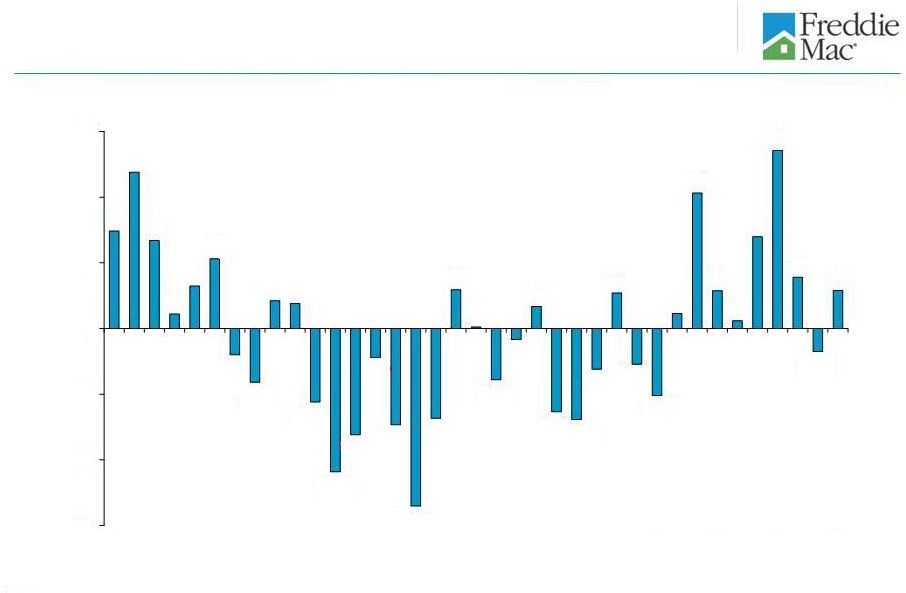 20
National home prices have experienced a cumulative
decline of 15% since June 2006
3.0
4.8
2.7
0.4
1.3
2.1
(0.8)
(1.6)
0.8
0.8
(2.2)
(4.4)
(3.2)
(0.9)
(2.9)
(5.4)
(2.7)
1.2
0.0
(1.6)
(0.3)
0.7
(2.5)
(2.8)
(1.2)
1.1
(1.1)
(2.0)
0.5
4.1
1.2
0.2
2.8
5.4
1.6
(0.7)
1.2
(6)
(4)
(2)
0
2
4
6
1Q
2005
4Q
2005
3Q
2006
2Q
2007
1Q
2008
4Q
2008
3Q
2009
2Q
2010
1Q
2011
4Q
2011
3Q
2012
2Q
2013
1Q
2014
Percent
(%)
National home prices use the Freddie Mac House Price Index for the U.S., which is a value-weighted
average of the state indexes where the value weights are based on Freddie Mac’s single-
family credit guarantee portfolio. Other indices of home prices may have different results, as
they are determined using different pools of mortgage loans and calculated under different
conventions than Freddie Mac’s. The Freddie Mac House Price Index for the U.S. is a
non-seasonally adjusted monthly series; quarterly growth rates are calculated as a 3-month change based
on the final month of each quarter. Seasonal factors typically result in stronger
house-price appreciation during the second and third quarters. Historical quarterly growth rates change as new
data becomes available. Values for the most recent periods typically see the largest
changes. Cumulative decline calculated as the percent change from June 2006 to March 2014.
Source: Freddie Mac.
1
1 |
 4%
AK
0%
-13 to -1%
-22%
-21 to -14%
CT -23%
DC 26%
DE -16%
0%
HI
RI -29%
MA
MD
NJ -23%
Home price performance by state
June
2006
to
March
2014
United States -
15%
1
The Freddie Mac House Price Index for the U.S. is a value-weighted average of
the state indexes where the value weights are based on Freddie Mac’s single-family credit
guarantee portfolio. Other indices of home prices may have different results,
as they are determined using different pools of mortgage loans and calculated under different
conventions.
The
Freddie
Mac
House
Price
Index
for
the
U.S.
is
a
non-seasonally
adjusted
monthly
series.
Source: Freddie Mac
21
-6%
AL
-4%
AR
-28%
AZ
-20%
CA
7%
CO
-35%
FL
-16%
GA
1%
IA
-16%
ID
-24%
IL
-5%
IN
-1%
KS
KY -4%
2%
LA
-21%
-15%
ME
-21%
MI
-17%
MN
-13%
MO
-7%
MS
4%
MT
NC -7%
38%
ND
2%
NE
-12%
NM
-41%
NV
-11%
NY
-15%
OH
7%
OK
-11%
OR
-9%
PA
-9%
SC
9%
SD
TN -1%
17%
TX
0%
UT
-14%
VA
-6%
VT
-14%
WA
-16%
WI
1%
WV
6%
WY
-20%
NH
-11%
1 |
 6%
AL
1%
AK
9%
4 to 8%
-3 to 0%
1 to 3%
-1%
AR
12%
AZ
16%
CA
8%
CO
CT 0%
DC 10%
DE 5%
9%
FL
9%
GA
8%
HI
3%
IA
6%
ID
6%
IL
3%
IN
3%
KS
KY 1%
2%
LA
4%
-3%
ME
11%
MI
6%
MN
4%
MO
1%
MS
7%
MT
NC 3%
6%
ND
4%
NE
NJ 2%
2%
NM
18%
NV
2%
NY
4%
OH
2%
OK
11%
OR
0%
PA
RI 2%
4%
SC
2%
SD
TN 5%
8%
TX
7%
UT
3%
VA
7%
WA
3%
WI
1%
WV
4%
WY
3%
6%
MD
MA
NH
Home price performance by state
March
2013
to
March
2014
1
United States 8%
1
The Freddie Mac House Price Index for the U.S. is a value-weighted average of
the state indexes where the value weights are based on Freddie Mac’s single-family credit
guarantee portfolio. Other indices of home prices may have different results, as
they are determined using different pools of mortgage loans and calculated under different
conventions.
The
Freddie
Mac
House
Price
Index
for
the
U.S.
is
a
non-seasonally
adjusted
monthly
series.
Source: Freddie Mac
22
0%
VT |
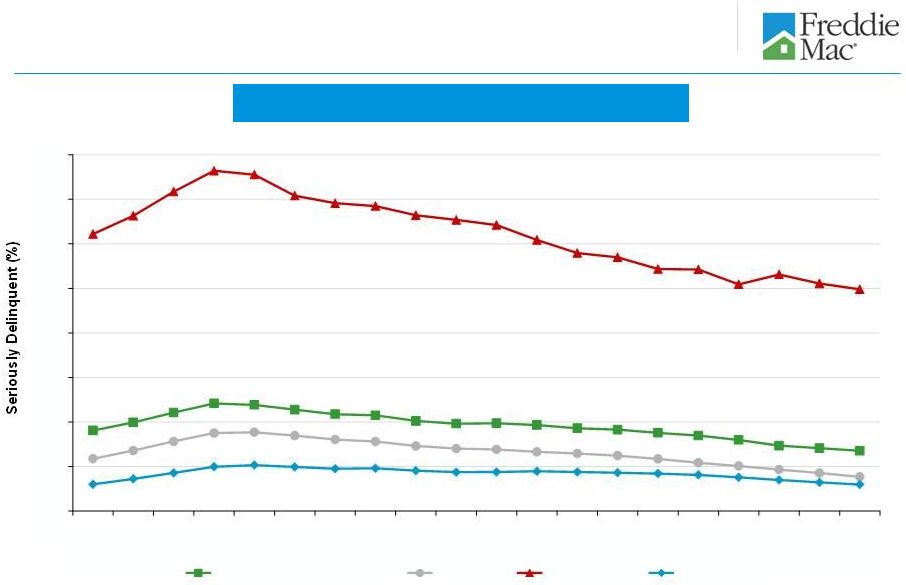 23
19.92%
5.41%
3.08%
2.39%
Single-family Serious Delinquency Rates
Mortgage market and Freddie Mac serious delinquency
rates
0
4
8
12
16
20
24
28
32
Mar-
09
Jun-
09
Sep-
09
Dec-
09
Mar-
10
Jun-
10
Sep-
10
Dec-
10
Mar-
11
Jun-
11
Sep-
11
Dec-
11
Mar-
12
Jun-
12
Sep-
12
Dec-
12
Mar-
13
Jun-
13
Sep-
13
Dec-
13
Total Mortgage Market
Prime
¹
Subprime
¹
Freddie Mac
¹
²
1
2
Source: National Delinquency Survey from the Mortgage Bankers Association. Categories represent
first lien single-family loans. Data is not yet available for the first quarter of
2014.
See “MD&A – RISK MANAGEMENT – Credit Risk – Mortgage Credit
Risk – Single-Family Mortgage Credit Risk – Credit Performance – Delinquencies” in Freddie Mac’s Form 10-K
for the year ended December 31, 2013, for information about the company’s reported delinquency
rates. The single-family serious delinquency rate at March 31, 2014 was 2.20%. |
 24
Total
Refinance
Loans:
53%
Loan purpose of single-family credit guarantee
portfolio purchases
1
The relief refinance mortgage initiative is Freddie Mac’s implementation of
the Home Affordable Refinance Program (HARP). Under the program, the company allows eligible
borrowers who have mortgages with high current LTV ratios to refinance their
mortgages without obtaining new mortgage insurance in excess of what was already in place. HARP is
targeted at borrowers with current LTV ratios above 80%; however, Freddie
Mac’s relief refinance initiative also allows borrowers with LTV ratios at or below 80% to participate.
Percent (%)
3
2005
2006
2007
2008
2009
2010
2011
2012
2013
1Q
2014
Purchase
Other Refinance
HARP
¹
Relief
Refinance
(Non-HARP)
¹ |
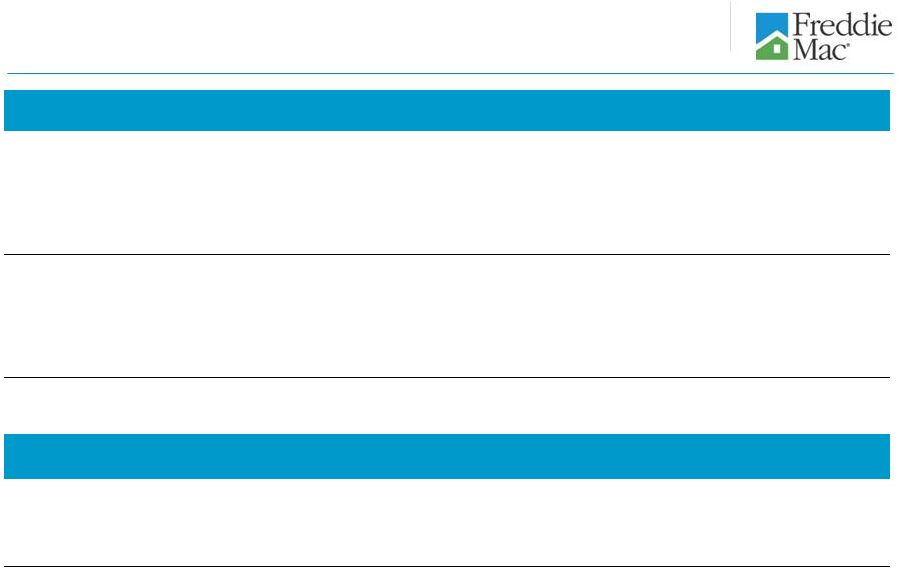 25
Credit quality of single-family credit guarantee portfolio
purchases
2009
2010
2011
2012
2013
1Q
2014
Weighted
Average
Original
LTV
Ratio
¹
Relief refinance (includes HARP)
80%
77%
77%
97%
91%
86%
All other
66%
67%
67%
68%
71%
75%
Total purchases
67%
70%
70%
76%
75%
77%
Weighted
Average
Credit
Score
²
Relief refinance (includes HARP)
738
747
744
740
727
711
All other
757
758
759
762
756
747
Total purchases
756
755
755
756
749
740
2009
2010
2011
2012
2013
1Q
2014
Purchase
of
Relief
Refinance
Mortgages
>
80%
LTV
(HARP
loans)
³
$ Billions
$19.6
$47.9
$39.7
$86.9
$62.5
$5.2
% of single-family credit guarantee portfolio purchases
4%
12%
12%
20%
15%
10%
Original LTV ratios are calculated as the unpaid principal balance (UPB) of the mortgage
Freddie Mac guarantees including the credit-enhanced portion, divided by the lesser of the
appraised value of the property at the time of mortgage origination or the mortgage borrower’s
purchase price. Second liens not owned or guaranteed by Freddie Mac are excluded from the
LTV ratio calculation. The existence of a second lien mortgage reduces the borrower’s equity in the home and, therefore, can increase the risk of default.
Credit score data is based on FICO scores at the time of origination and may not be
indicative of the borrowers’ current creditworthiness. FICO scores can range between
approximately 300 to 850 points.
HARP is the portion of the company’s relief refinance initiative targeted at
borrowers with current LTV ratios above 80%. 1
2
3 |
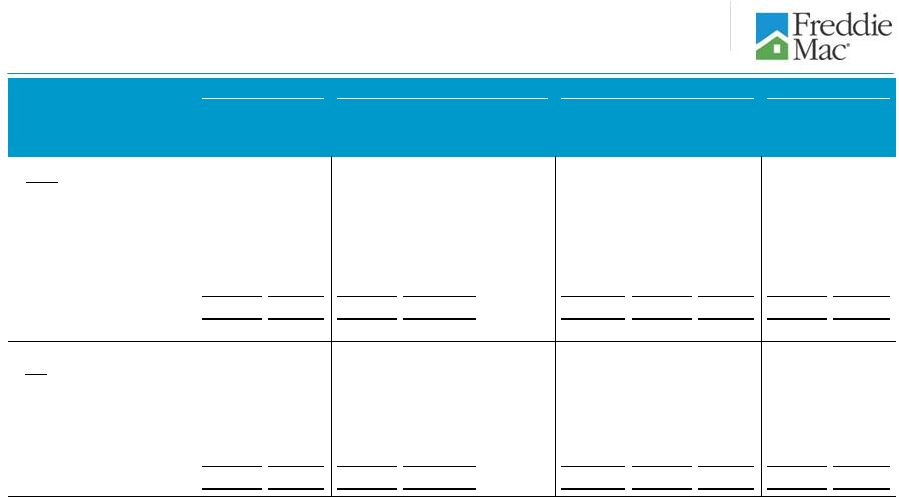 26
Single-family 1Q 2014 credit losses and REO
by region and state
($ Billions)
% of Total
UPB
2
($ Millions)
% of Total
Serious
Delinquency
Rate
3
(%)
1Q 2014
Acquisitions
($ Millions)
REO
Inventory
($ Millions)
% of Total
Inventory
($ Millions)
% of Total
Region
6
1
West
$465
28%
$7,896
20%
1.55%
$423
$1,080
15%
$79
8%
2
Northeast
430
26
15,014
38
3.10%
411
1,517
22
258
27
3
North Central
289
18
5,118
13
1.67%
422
1,778
26
228
23
4
Southeast
272
16
9,378
23
3.07%
810
2,125
30
356
37
5
Southwest
195
12
2,242
6
1.25%
151
461
7
46
5
6
Total
$1,651
100%
$39,648
100%
2.20%
$2,217
$6,961
100%
$967
100%
State
7
Arizona,
California,
Florida
&
Nevada
7
$423
26%
$11,204
28%
2.63%
$861
$2,130
31%
$310
32%
8
Illinois,
Michigan
&
Ohio
8
174
10
3,732
10
1.95%
291
1,326
19
168
17
9
New
York
&
New
Jersey
9
145
9
8,759
22
4.98%
91
274
4
103
11
10
All other
909
55
15,953
40
1.72%
974
3,231
46
386
40
11
Total
$1,651
100%
$39,648
100%
2.20%
$2,217
$6,961
100%
$967
100%
Total Portfolio UPB
1
Seriously Delinquent Loans
REO Acquisitions & Balance
4
Credit
Losses
5
Based on the unpaid principal balance (UPB) of the single-family credit guarantee portfolio at
March 31, 2014.
UPB amounts exclude $394 million of Other Guarantee Transactions since these securities are backed by
non-Freddie Mac issued securities for which loan characteristic data was not available.
Based on the number of loans that are three monthly payments or more past due or in the process of
foreclosure.
Based on the UPB of loans at the time of REO acquisition. Consist of the
aggregate amount of charge-offs, net of recoveries, and REO operations (income) expense for 1Q 2014.
Region designation: West (AK, AZ, CA, GU, HI, ID, MT, NV, OR, UT, WA); Northeast (CT, DE, DC, MA, ME,
MD, NH, NJ, NY, PA, RI, VT, VA, WV); Southeast (AL, FL, GA, KY, MS, NC, PR, SC, TN, VI); North
Central (IL, IN, IA, MI, MN, ND, OH, SD, WI); and Southwest (AR, CO, KS, LA, MO, NE, NM, OK, TX, WY).
Represents the four states that had the largest cumulative declines in home prices during the housing
crisis that began in 2006, as measured using Freddie Mac’s home price index.
Represents selected states in the North Central region that have experienced adverse economic
conditions since 2006.
Represents two states with a judicial foreclosure process in which there are a significant number of
seriously delinquent loans within Freddie Mac’s single-family credit guarantee portfolio.
1
2
3
4
5
6
7
8
9 |
 1.2%
Single-family serious delinquency rates by state and
region
27
Single-family Serious Delinquency Rates
By State
1,2
Single-family Serious Delinquency Rates
By Region
1,3
1
Based
on
the
number
of
loans
that
are
three
monthly
payments
or
more
past
due
or
in
the
process
of
foreclosure.
See
“MD&A
–
RISK
MANAGEMENT
–
Credit
Risk
–
Mortgage
Credit
Risk
–
Single-Family
Mortgage
Credit
Risk
–
Credit
Performance
–
Delinquencies”
in
Freddie
Mac’s
Form
10-K
for
the
year
ended
December
31,
2013,
for
information
about
the company’s reported delinquency rates.
2
States presented are those with the highest number of seriously delinquent loans
within Freddie Mac’s single-family credit guarantee portfolio as of March 31, 2014.
3
Region designation: West (AK, AZ, CA, GU, HI, ID, MT, NV, OR, UT, WA); Northeast
(CT, DE, DC, MA, ME, MD, NH, NJ, NY, PA, RI, VT, VA, WV); Southeast (AL, FL, GA, KY, MS, NC,
PR, SC, TN, VI); North Central (IL, IN, IA, MI, MN, ND, OH, SD, WI); and Southwest
(AR, CO, KS, LA, MO, NE, NM, OK, TX, WY). 1.7%
2.2%
3.1%
3.1%
5.6%
6.0%
2.2%
2.5%
4.3%
1.3%
1.6%
0
2
4
6
8
10
12
14
1Q
2011
2Q
2011
3Q
2011
4Q
2011
1Q
2012
2Q
2012
3Q
2012
4Q
2012
1Q
2013
2Q
2013
3Q
2013
4Q
2013
1Q
2014
Percent
California
Florida
Illinois
New Jersey
New York
Total
0
1
2
3
4
5
6
1Q
2011
2Q
2011
3Q
2011
4Q
2011
1Q
2012
2Q
2012
3Q
2012
4Q
2012
1Q
2013
2Q
2013
3Q
2013
4Q
2013
1Q
2014
Percent
West
Northeast
North Central
Southeast
Southwest
Total |
 Aging
of single-family seriously delinquent loans by judicial and
non-judicial states 28
1
Excludes loans underlying certain single-family Other Guarantee Transactions
since the geographic information is not available to us for these loans. As of March 31, 2014, the
states and territories classified as having a judicial foreclosure process consist
of: CT, DE, FL, HI, IA, IL, IN, KS, KY, LA, ME, ND, NE, NJ, NM, NY, OH, OK, OR, PA, PR, SC, SD, VI,
VT and WI. All other states are classified as having a non-judicial
foreclosure process. Judicial foreclosures are those conducted under the supervision of a court.
# of Seriously
Delinquent
Loans
Percent
# of Seriously
Delinquent
Loans
Percent
# of Seriously
Delinquent
Loans
Percent
Judicial
Review
States
¹
Less than or equal to 1 year
73,887
23%
59,129
23%
54,249
23%
More than 1 year and less than or equal to 2 years
45,464
14%
30,604
12%
27,853
12%
More than 2 years
76,125
24%
65,154
26%
61,022
26%
Non-Judicial
States
¹
Less than or equal to 1 year
78,209
24%
60,175
24%
54,636
24%
More than 1 year and less than or equal to 2 years
26,764
8%
17,968
7%
16,263
7%
More than 2 years
23,062
7%
19,731
8%
18,427
8%
Combined
¹
Less than or equal to 1 year
152,096
47%
119,304
47%
108,885
47%
More than 1 year and less than or equal to 2 years
72,228
22%
48,572
19%
44,116
19%
More than 2 years
99,187
31%
84,885
34%
79,449
34%
Total
323,511
100%
252,761
100%
232,450
100%
As of 03/31/13
As of 12/31/13
As of 03/31/14 |
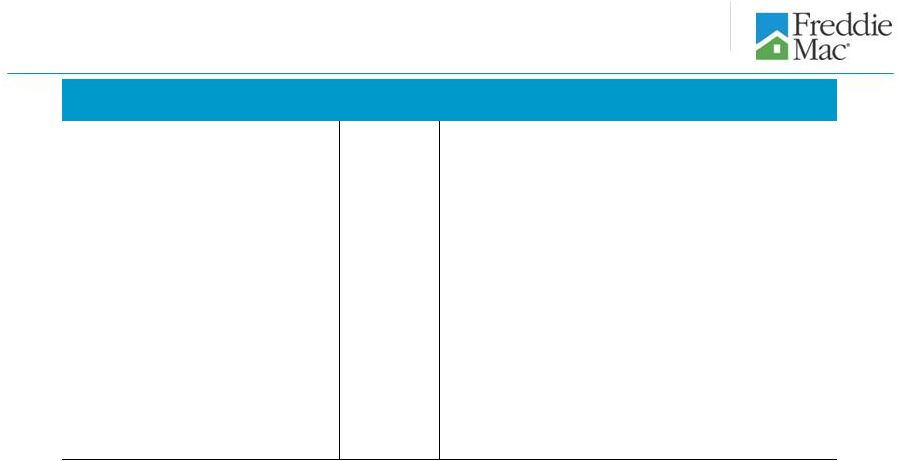 29
Single-family
credit
guarantee
portfolio
characteristics
1
Option
FICO
FICO
Original
LTV
FICO < 620 &
Original
Attribute
Alt-A
2
Interest-only
3
ARM
< 620
4
620
–
659
4
> 90%
LTV
>
90%
4
1
UPB $ Billions
$1,651
$55
$33
$6
$47
$95
$261
$13
2
Percent of Total Portfolio
100%
3%
2%
0%
3%
6%
16%
1%
3
Average UPB per loan
$154,848
$154,270
$223,688
$197,819
$126,234
$132,838
$169,771
$137,156
4
Fixed Rate (% of total portfolio)
94%
63%
17%
0%
95%
94%
98%
98%
5
Owner Occupied
90%
82%
80%
76%
95%
93%
91%
95%
6
Original Loan-to-Value (OLTV)
75%
73%
74%
71%
81%
80%
107%
107%
7
OLTV > 90%
16%
4%
3%
2%
27%
23%
100%
100%
8
Current Loan-to-Value (CLTV)
69%
86%
91%
84%
82%
79%
97%
102%
9
CLTV > 90%
16%
44%
50%
39%
36%
32%
59%
67%
10
CLTV > 100%
9%
31%
34%
26%
25%
21%
33%
48%
11
CLTV > 110%
5%
21%
21%
17%
16%
13%
20%
31%
12
Average
FICO
Score
4
739
710
718
707
584
643
725
582
13
FICO
<
620
4
3%
5%
3%
4%
100%
0%
5%
100%
Book
Year
5
14
2014
1%
0%
0%
0%
0%
1%
1%
0%
15
2013
17%
0%
0%
0%
1%
6%
11%
1%
16
2012
16%
0%
0%
0%
1%
3%
7%
0%
17
2011
7%
0%
0%
0%
1%
2%
2%
0%
18
2010
7%
0%
1%
0%
1%
3%
2%
0%
19
2009
7%
0%
1%
0%
2%
3%
1%
1%
20
New single-family book (2009 to 2014)
55%
0%
2%
0%
6%
18%
24%
2%
21
HARP
and
other
relief
refinance
loans
6
21%
0%
0%
0%
30%
23%
60%
56%
22
2005 to 2008 Legacy single-family book
15%
84%
94%
71%
43%
39%
10%
26%
23
Pre-2005 Legacy single-family book
9%
16%
4%
29%
21%
20%
6%
16%
24
%
of
Loans
with
Credit
Enhancement
7
13%
11%
9%
15%
22%
19%
49%
52%
25
%
Seriously
Delinquent
8
2.20%
9.66%
11.55%
11.67%
9.29%
6.65%
2.93%
8.87%
Total Portfolio
as of
March 31, 2014
Portfolio characteristics are based on the unpaid principal balance (UPB) of the single-family
credit guarantee portfolio. Approximately $1 billion in UPB for Other Guarantee Transactions
is included in total UPB and percentage seriously delinquent but not included in the calculation of
other statistics since these securities are backed by non-Freddie Mac issued securities for
which loan characteristic data was not available.
For a description of Alt-A, see the “Glossary” in the company’s Quarterly Report on
Form 10-Q for the quarter ended March 31, 2014.
Beginning September 1, 2010, the company fully discontinued purchases of interest-only loans. Represents the
FICO score of the borrower at loan origination. The company estimates that less than 1% of loans within the portfolio are missing origination FICO scores and as such
are excluded.
Indicates year of loan origination (except for HARP and other relief refinance loans).
Calculated based on the loans remaining in the portfolio as of March 31, 2014, rather than all loans
originally guaranteed by the company and originated in the respective year. Each Book Year
category represents the percentage of loans referenced in line 1 of the same vertical column.
Individual book years exclude HARP and other relief refinance loans originated in that year. See endnote (6).
HARP and other relief refinance loans are presented separately rather than in the year in which the
refinancing occurred (from 2009 to 2014). All other refinance loans are presented within
the year that the refinancing occurred.
Excludes credit enhancement coverage occurring subsequent to the company’s purchase or guarantee,
such as STACR debt notes or other risk transfer transactions (i.e., K certificate
transactions). Including subsequently obtained coverage, the percentage for the total portfolio with credit enhancement was 19% as of March 31, 2014.
Based on the number of loans that are three monthly payments or more past due or in the process of
foreclosure.
Note: Individual categories are not mutually exclusive, and therefore are not additive across columns.
1
2
3
4
5
6
7
8 |
 30
Single-family credit profile by book year and product
feature
1
Attribute
2014
2013
2012
2011
2010
2009
New single-
family book
(2009 to 2014)
HARP and
other relief
refinance
loans
³
2005 to 2008
Legacy single-
family book
Pre-2005
Legacy single-
family book
1
UPB $ Billions
$1,651
$20
$285
$260
$116
$110
$116
$907
$343
$255
$146
2
Original Loan-to-Value (OLTV)
75%
75%
71%
69%
69%
69%
69%
70%
89%
75%
73%
3
OLTV > 90%
16%
14%
10%
7%
5%
4%
3%
7%
45%
11%
11%
4
Current Loan-to-Value (CLTV)
69%
75%
68%
60%
58%
59%
62%
63%
80%
86%
49%
5
CLTV > 100%
9%
0%
0%
0%
0%
0%
1%
0%
20%
28%
2%
6
CLTV > 110%
5%
0%
0%
0%
0%
0%
0%
0%
12%
18%
1%
7
Average
FICO
Score
4
739
747
754
761
756
754
751
756
735
703
710
8
FICO
<
620
4
3%
0%
0%
0%
0%
0%
1%
0%
4%
8%
7%
9
Adjustable-rate
6%
6%
5%
5%
8%
4%
1%
5%
1%
15%
12%
10
Interest-only
5
2%
0%
0%
0%
0%
0%
0%
0%
0%
12%
1%
11
Investor
6%
7%
6%
4%
5%
5%
3%
5%
9%
6%
5%
12
Condo
7%
8%
7%
5%
5%
6%
7%
6%
9%
11%
8%
Geography
13
Arizona,
California,
Florida
&
Nevada
6
26%
32%
27%
26%
21%
18%
17%
24%
28%
31%
22%
14
Illinois,
Michigan
&
Ohio
7
10%
8%
10%
10%
9%
10%
9%
10%
13%
9%
14%
15
New
York
&
New
Jersey
8
9%
7%
8%
7%
10%
9%
10%
8%
8%
10%
11%
16
All other states
55%
53%
55%
57%
60%
63%
64%
58%
51%
50%
53%
17
% of
Loans
with
Credit
Enhancement
9
13%
24%
18%
13%
10%
8%
8%
13%
12%
18%
10%
18
% Seriously
Delinquent
10
2.20%
0.00%
0.01%
0.05%
0.20%
0.40%
0.87%
0.24%
0.65%
8.25%
3.16%
Total Portfolio
as of
March 31, 2014
Book Year
²
Portfolio characteristics are based on the unpaid principal balance (UPB) of the single-family
credit guarantee portfolio. Approximately $1 billion in UPB for Other Guarantee Transactions is
included in total UPB and percentage seriously delinquent but not included in the calculation of other
statistics since these securities are backed by non-Freddie Mac issued securities for which
loan characteristic data was not available. Indicates year
of loan origination (except for HARP and other relief refinance loans). Calculated based on the loans remaining in the portfolio as of March 31, 2014, rather than all loans originally
guaranteed by the company and originated in the respective year. Individual book years exclude
HARP and other relief refinance loans originated in that year. See endnote (3).
HARP and other relief refinance loans are presented separately rather than in the year in which the
refinancing occurred (from 2009 to 2014). All other refinance loans are presented within the
year that the refinancing occurred. Represents the
average of the borrowers’ FICO scores at origination. The company estimates that less than 1% of loans within the portfolio are missing FICO scores and as such are excluded. Beginning
September 1, 2010, the company fully discontinued purchases of interest-only loans.
Represents the four states that had the largest cumulative declines in home prices during the housing
crisis that began in 2006, as measured using Freddie Mac’s home price index.
Represents selected states in the North Central region that have experienced adverse economic
conditions since 2006.
Represents two states with a judicial foreclosure process in which there are a significant number of
seriously delinquent loans within Freddie Mac’s single-family credit guarantee portfolio.
Excludes credit enhancement coverage occurring subsequent to the company’s purchase or guarantee,
such as STACR debt notes or other risk transfer transactions (i.e., K certificate
transactions). Including subsequently obtained coverage, the percentage for the total portfolio
with credit enhancement was 19% as of March 31, 2014.
Based on the number of loans that are three monthly payments or more past due or in the process of
foreclosure.
1
2
3
4
5
6
7
8
9
10 |
 31
Single-family cumulative foreclosure transfer and
short
sale
rates
1
by
book
year
2007
2006
2005
2004
2014
2008
2009
2010
2011
2013
2012
1
Rates are calculated for each year of origination as the number of loans that have proceeded to
foreclosure transfer or short sale and resulted in a credit loss, excluding any subsequent
recoveries, divided by the number of loans originated in that year that were acquired in the company’s single-family credit guarantee portfolio. Includes
Other Guarantee Transactions where loan characteristic data is available.
0.00%
1.00%
2.00%
3.00%
4.00%
5.00%
6.00%
7.00%
8.00%
9.00%
10.00%
11.00%
12.00%
Yr1
Q1
Yr1
Q3
Yr2
Q1
Yr2
Q3
Yr3
Q1
Yr3
Q3
Yr4
Q1
Yr4
Q3
Yr5
Q1
Yr5
Q3
Yr6
Q1
Yr6
Q3
Yr7
Q1
Yr7
Q3
Yr8
Q1
Yr8
Q3
Yr9
Q1
Yr9
Q3
Yr10
Q1
Yr10
Q3
Yr11
Q1
2004
2005
2006
2007
2008
2009
2010
2011
2012
2013
2014
Quarter Post Origination |
 32
Total Multifamily (MF) Portfolio
UPB $ Billions
Multifamily portfolio composition
$167
$165
$135
$154
$164
$169
$177
$180
12/31/07
12/31/08
12/31/09
12/31/10
12/31/11
12/31/12
12/31/13
03/31/14
MF loan portfolio
MF investment securities portfolio
MF guarantee portfolio |
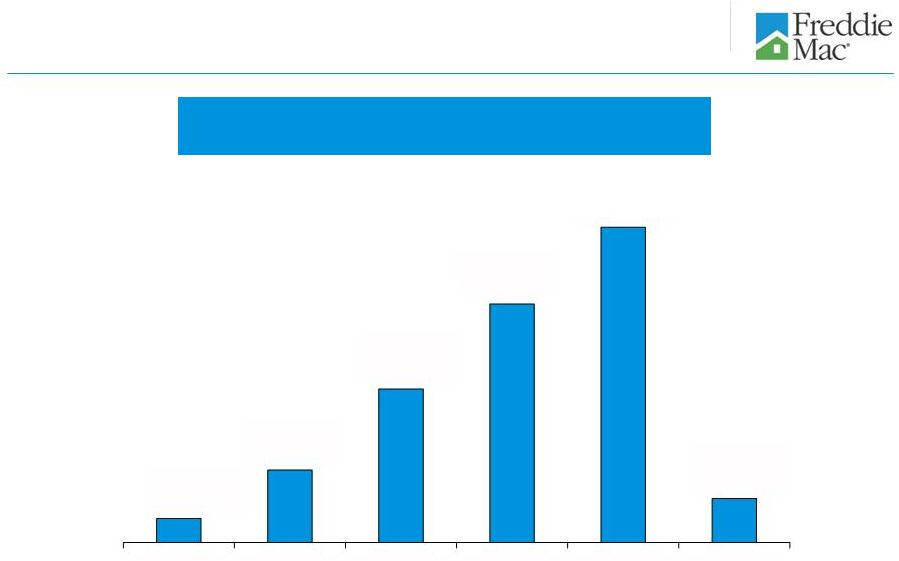 33
K-Deal
Securitization
Volume
¹
UPB $ Billions
Multifamily securitization volume
1
Total UPB represents the total collateral UPB of multifamily loans sold via Freddie
Mac’s K Certificate transactions. 2
Data as of March 31, 2014.
$2.1
$6.4
$13.7
$21.2
$28.0
$3.9
2009
2010
2011
2012
2013
YTD
2014
² |
 AL
1.0%
AK
0.0%
> 5%
> 3% -
5%
1%
> 1% -
3%
AR
0.1%
AZ
2.0%
CA
7.0%
CO
3.7%
CT
0.3%
DC
1.2%
DE
0.0%
FL
5.5%
GA
6.2%
HI
0.0%
IA
0.9%
ID
<0.1%
IL
1.9%
IN
0.8%
KS
0.1%
KY
0.7%
LA
0.0%
MD
2.4%
ME
0.0%
MI
0.9%
MN
1.4%
MO
0.6%
MS
0.0%
MT
0.0%
NC
2.6%
ND
0.0%
NE
1.1%
NJ
1.2%
NM
0.0%
NV
1.7%
NY
14.1%
OH
5.0%
OK
0.4%
OR
0.9%
PA
1.2%
RI
<0.1%
SC
<0.1%
SD
0.5%
TN
1.7%
TX
23.5%
UT
1.0%
VA
2.4%
VT
0.0%
WA
2.0%
WI
0.8%
WV
0.0%
WY
0.1%
NH
0.0%
34
MA 3.0%
MF New Business Volume $3.0B
For the Three Months Ended March 31, 2014
1
Based on the unpaid principal balance (UPB) of the multifamily loan purchases and issuance of other
guarantee commitments and other structured securities. Percentages shown above are
rounded to the nearest tenth of a percent although classifications are based on unrounded figures.
Multifamily
new
business
volume
by
state
(%)
1 |
 Multifamily mortgage portfolio UPB concentration by
state
1
AL
0.9%
AK
0.0%
AR
0.3%
AZ
2.4%
CA
16.6%
CO
3.0%
CT
0.9%
DC
0.7%
DE
0.2%
FL
7.0%
GA
4.3%
HI
0.2%
IA
0.2%
ID
<0.1%
IL
2.5%
IN
0.7%
KS
0.8%
KY
0.5%
LA
0.7%
MA 1.9%
MD
4.9%
ME
<0.1%
MI
1.0%
MN
1.2%
MO
1.1%
MS
0.3%
MT
<0.1%
NC
2.8%
ND
0.1%
NE
0.5%
NJ
2.7%
NM
0.3%
NV
1.1%
NY
8.5%
OH
2.0%
OK
0.5%
OR
0.9%
PA
2.5%
RI
0.2%
SC
0.9%
SD
<0.1%
TN
1.4%
TX
12.9%
UT
0.6%
VA
5.3%
VT
0.0%
WA
3.4%
WI
0.7%
WV
<0.1%
WY
<0.1%
NH
0.1%
35
5%
2% -
5%
1%
1% -
2%
MF Mortgage Portfolio $132.6B
2
As of March 31, 2014
1
2
Based on the unpaid principal balance (UPB) of unsecuritized mortgage loans, other guarantee
commitments, and collateral underlying other structured securities and K Certificate
transactions. Percentages shown above are rounded to the nearest tenth of a percent although
classifications are based on unrounded figures.
Consists of the UPB of unsecuritized multifamily loans, other guarantee commitments, and guaranteed
Freddie Mac mortgage-related securities. Excludes the UPB associated with
unguaranteed subordinated tranches in K Certificate transactions and other structured securities.
|
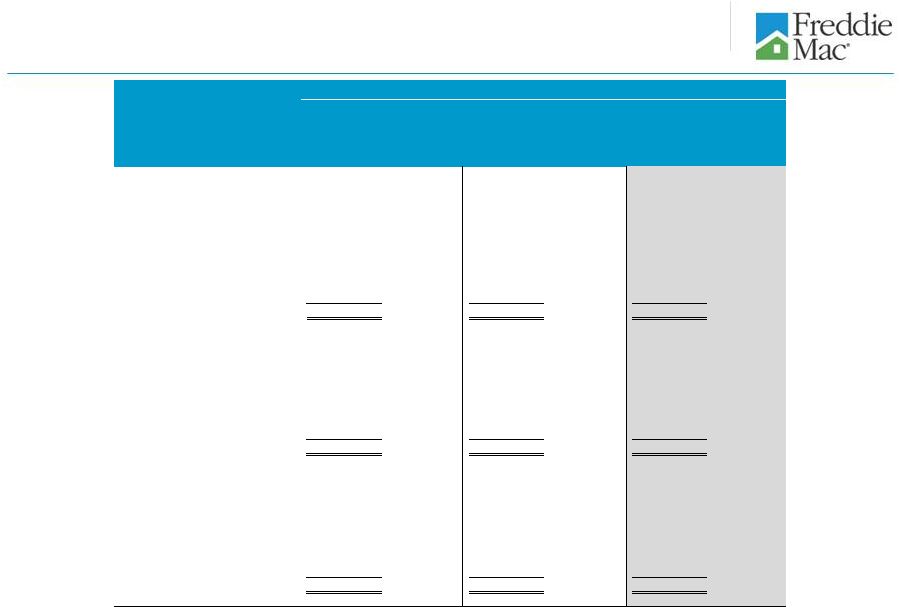 36
Multifamily
mortgage
portfolio
by
attribute
¹
Year
of
Acquisition
or
Guarantee
³
1
2007 and prior
$40.6
0.43%
$34.2
0.24%
$33.0
0.15%
2
2008
16.0
0.22
13.2
0.18
12.6
-
3
2009
12.1
-
11.2
-
11.0
-
4
2010
11.8
-
10.9
0.13
10.7
0.07
5
2011
16.9
-
15.9
-
15.7
-
6
2012
25.6
-
23.7
-
23.5
-
7
2013
6.0
-
23.7
-
23.2
-
8
2014
N/A
N/A
N/A
N/A
2.9
-
Total
$129.0
0.16%
$132.8
0.09%
$132.6
0.04%
Maturity Dates
9
2014
$7.1
0.28%
$2.1
0.12%
$1.4
0.20%
10
2015
9.2
0.15
6.9
0.05
6.5
-
11
2016
12.6
0.05
11.2
-
10.7
-
12
2017
10.6
0.19
10.0
0.43
9.8
0.27
13
2018
17.3
-
17.0
-
16.9
-
14
2019
18.2
-
17.5
0.07
17.6
0.05
15
Beyond 2019
54.0
0.27
68.1
0.09
69.7
0.03
Total
$129.0
0.16%
$132.8
0.09%
$132.6
0.04%
Geography
4
16
California
$21.2
0.10%
$22.4
0.03%
$22.3
-
%
17
Texas
16.0
0.13
16.7
0.02
16.9
-
18
New York
10.8
0.09
11.4
0.12
11.5
0.08
19
Florida
9.0
0.04
9.3
0.28
9.2
-
20
Virginia
7.0
-
7.0
0.37
6.9
0.38
21
Maryland
6.6
-
6.7
-
6.5
-
22
All other states
58.4
0.26
59.3
0.08
59.3
0.04
Total
$129.0
0.16%
$132.8
0.09%
$132.6
0.04%
UPB
($ Billions)
March 31, 2014
UPB
($ Billions)
Delinquency
Rate
²
(%)
December 31, 2013
Delinquency
Rate
²
(%)
March 31, 2013
Delinquency
Rate
²
(%)
UPB
($ Billions)
Based on the unpaid principal balance (UPB) of the multifamily mortgage portfolio.
Based on the UPB of mortgages two monthly payments or more past due or in the process of
foreclosure.
Based on either: (a) the year of acquisition, for loans recorded on the company’s consolidated
balance sheets; or (b) the year that the company issued its guarantee, for the remaining loans
in its multifamily mortgage portfolio. Presents the six states with the highest UPB at March 31, 2014.
1
2
3
4 |
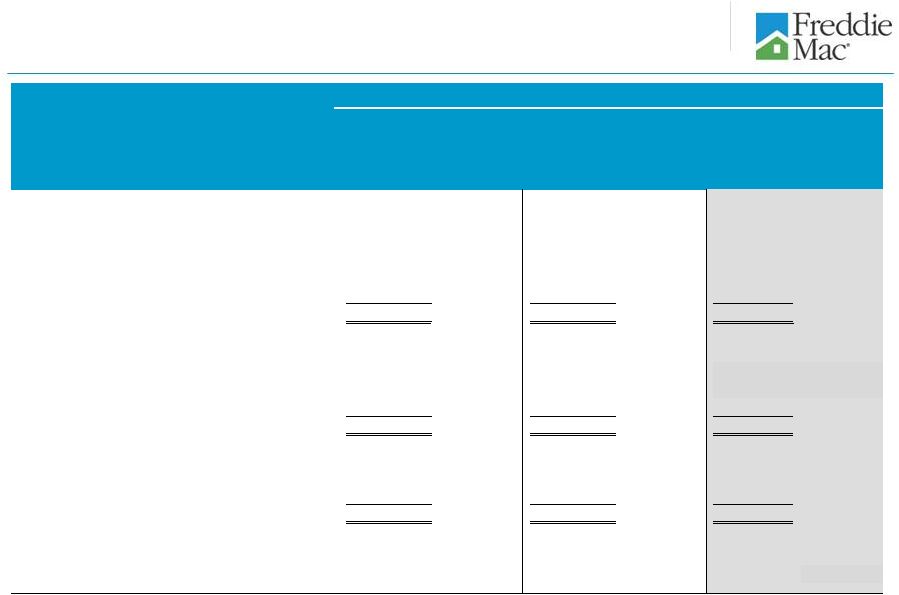 37
Multifamily
mortgage
portfolio
by
attribute,
continued
Current Loan Size
1
> $25M
$49.1
-
%
$50.6
0.05%
$50.1
0.05%
2
> $5M & <= $25M
71.0
0.26
73.2
0.11
73.4
0.03
3
> $3M & <= $5M
5.7
0.17
6.0
0.11
6.0
0.06
4
> $750K & <= $3M
3.0
0.56
2.8
0.17
2.9
0.17
5
<= $750K
0.2
0.37
0.2
0.46
0.2
0.26
6
Total
$129.0
0.16%
$132.8
0.09%
$132.6
0.04%
Legal Structure
7
Unsecuritized Loans
$73.7
0.06%
$59.2
0.08%
$55.9
0.02%
8
K Certificates
41.8
0.06
59.8
0.07
62.8
0.05
9
Other Freddie Mac mortgage-related securities
4.2
3.07
4.8
0.59
4.8
0.28
10
Other guarantee commitments
9.3
-
9.0
-
9.1
-
11
Total
$129.0
0.16%
$132.8
0.09%
$132.6
0.04%
Credit Enhancement
12
Credit Enhanced
$52.2
0.34%
$70.2
0.11%
$73.3
0.07%
13
Non-Credit Enhanced
76.8
0.04
62.6
0.07
59.3
0.02
14
Total
$129.0
0.16%
$132.8
0.09%
$132.6
0.04%
Other
15
Original LTV > 80%
$5.6
2.34%
$5.6
0.19%
$5.6
0.19%
16
Original
DSCR
below
1.10
³
$2.2
3.76%
$2.2
-
%
$2.2
-
%
March 31, 2014
UPB
($ Billions)
Delinquency
Rate
²
(%)
December 31, 2013
Delinquency
Rate
²
(%)
March 31, 2013
Delinquency
Rate
²
(%)
UPB
($ Billions)
UPB
($ Billions)
3
2
1
Based on the unpaid principal balance (UPB) of the multifamily mortgage portfolio. Based on the UPB
of mortgages two monthly payments or more past due or in the process of foreclosure.
DSCR – Debt Service Coverage Ratio – is an indicator of future credit performance for
multifamily loans. DSCR estimates a multifamily borrower’s ability to service its mortgage obligation using the secured
property’s cash flow, after deducting non-mortgage expenses from income. The higher the DSCR,
the more likely a multifamily borrower will be able to continue servicing its mortgage obligation.
¹ |
 0.00%
Multifamily market and Freddie Mac delinquency rates
Percent
1
38
6.24%
0.83%
0.09%
1
0
2
4
6
8
10
12
14
4Q 2009
2Q 2010
4Q 2010
2Q 2011
4Q 2011
2Q 2012
4Q 2012
2Q 2013
4Q 2013
Freddie Mac (60+ day)
FDIC Insured Institutions (90+ day)
MF CMBS Market (60+ day)
ACLI Investment Bulletin (60+ day)
See “MD&A – RISK MANAGEMENT – Credit Risk – Mortgage Credit Risk –
Multifamily Mortgage Credit Risk ” in Freddie Mac’s Form 10-K for the year ended December 31,
2013, for information about the company’s reported multifamily delinquency rate. The
multifamily delinquency rate at March 31, 2014 was 0.04%.
Source: Freddie Mac, FDIC Quarterly Banking Profile, TREPP (CMBS multifamily 60+ delinquency rate,
excluding REOs), American Council of Life Insurers (ACLI). Non-Freddie Mac data is not
yet available for the first quarter of 2014. |
 39
Safe Harbor Statements
Freddie Mac obligations
Freddie Mac’s securities are obligations of Freddie Mac only. The securities,
including any interest or return of discount on the securities, are not
guaranteed by and are not debts or obligations of the United States or any federal agency or instrumentality other than Freddie
Mac.
No offer or solicitation of securities
This
presentation
includes
information
related
to,
or
referenced
in
the
offering
documentation
for,
certain
Freddie
Mac
securities,
including offering circulars and related supplements and agreements. Freddie Mac
securities may not be eligible for offer or sale in certain
jurisdictions
or
to
certain
persons.
This
information
is
provided
for
your
general
information
only,
is
current
only
as
of
its
specified
date and does not constitute an offer to sell or a solicitation of an offer to buy
securities. The information does not constitute a sufficient basis
for
making
a
decision
with
respect
to
the
purchase
or
sale
of
any
security.
All
information
regarding
or
relating
to
Freddie
Mac
securities
is
qualified
in
its
entirety
by
the
relevant
offering
circular
and
any
related
supplements.
Investors
should
review
the
relevant
offering circular and any related supplements before making a decision with respect
to the purchase or sale of any security. In addition, before purchasing any
security, please consult your legal and financial advisors for information about and analysis of the security, its
risks and its suitability as an investment in your particular circumstances.
Forward-looking statements
Freddie Mac's presentations may contain forward-looking statements, which may
include statements pertaining to the conservatorship, the company’s
current expectations and objectives for its single-family, multifamily and investment businesses, its loan workout
initiatives and other efforts and other programs to assist the U.S. residential
mortgage market, liquidity, capital management, economic and market
conditions and trends, market share, the effect of legislative and regulatory developments, and new accounting guidance,
credit quality of loans we guarantee, and results of operations and financial
condition on a GAAP, Segment Earnings and fair value basis.
Forward-looking statements involve known and unknown risks and uncertainties, some of which are beyond the company’s
control. Management’s expectations for the company’s future necessarily
involve a number of assumptions, judgments and estimates, and various
factors, including changes in market conditions, liquidity, mortgage spreads, credit outlook, actions by the U.S. government
(including FHFA, Treasury and Congress), and the impacts of legislation or
regulations and new or amended accounting guidance, could cause actual
results to differ materially from these expectations. These assumptions, judgments, estimates and factors are discussed in
the
company’s
Annual
Report
on
Form
10-K
for
the
year
ended
December
31,
2013,
Quarterly
Report
on
Form
10-Q
for
the
quarter
ended March 31, 2014 and Current Reports on Form 8-K, which are available on
the Investor Relations page of the company’s Web site at
www.FreddieMac.com/investors and the SEC’s Web site at www.sec.gov. The company undertakes no obligation to update forward-
looking statements it makes to reflect events or circumstances after the date of
this presentation. |
